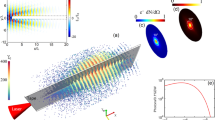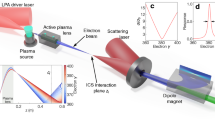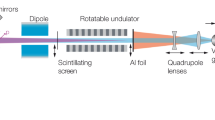Abstract
Electron and X-ray beams originating from compact laser-wakefield accelerators have very small source sizes that are typically on the micrometre scale. Therefore, the beam divergences are relatively high, which makes it difficult to preserve their high quality during transport to applications. To improve on this, tremendous efforts have been invested in controlling the divergence of the electron beams, but no mechanism for generating collimated X-ray beams has yet been demonstrated experimentally. Here we propose and realize a scheme where electron bunches undergoing focusing in a dense, passive plasma lens can emit X-ray pulses with divergences approaching the incoherent limit. Compared with conventional betatron emission, the divergence of this so-called plasma lens radiation is reduced by more than an order of magnitude in solid angle, while maintaining a similar number of emitted photons per electron. This X-ray source offers the possibility of producing brilliant and collimated few-femtosecond X-ray pulses for ultra-fast science, in particular for studies based on X-ray diffraction and absorption spectroscopy.
This is a preview of subscription content, access via your institution
Access options
Access Nature and 54 other Nature Portfolio journals
Get Nature+, our best-value online-access subscription
$29.99 / 30 days
cancel any time
Subscribe to this journal
Receive 12 print issues and online access
$209.00 per year
only $17.42 per issue
Buy this article
- Purchase on Springer Link
- Instant access to full article PDF
Prices may be subject to local taxes which are calculated during checkout





Similar content being viewed by others
Data availability
Data that support the plots within this paper and other findings of this study are available from the corresponding author upon reasonable request. Source data are provided with this paper.
Code availability
The codes that support the findings of this study are available from the corresponding authors upon reasonable request.
References
Tajima, T. & Dawson, J. M. Laser electron accelerator. Phys. Rev. Lett. 43, 267–270 (1979).
Barber, S. K. et al. Measured emittance dependence on the injection method in laser plasma accelerators. Phys. Rev. Lett. 119, 104801 (2017).
Lundh, O. et al. Few femtosecond, few kiloampere electron bunch produced by a laser-plasma accelerator. Nat. Phys. 7, 219–222 (2011).
Buck, A. et al. Real-time observation of laser-driven electron acceleration. Nat. Phys. 7, 543–548 (2011).
Phuoc, K. T. et al. Imaging electron trajectories in a laser-wakefield cavity using betatron X-ray radiation. Phys. Rev. Lett. 97, 225002 (2006).
Albert, F. et al. Betatron oscillations of electrons accelerated in laser wakefields characterized by spectral X-ray analysis. Phys. Rev. E 77, 056402 (2008).
Kneip, S. et al. Bright spatially coherent synchrotron X-rays from a table-top source. Nat. Phys. 6, 980–983 (2010).
Corde, S. et al. Femtosecond X-rays from laser-plasma accelerators. Rev. Mod. Phys. 85, 1–48 (2013).
Migliorati, M. et al. Intrinsic normalized emittance growth in laser-driven electron accelerators. Phys. Rev. ST Accel. Beams 16, 011302 (2013).
Floettmann, K. Adiabatic matching section for plasma accelerated beams. Phys. Rev. ST Accel. Beams 17, 054402 (2014).
Xu, X. L. et al. Physics of phase space matching for staging plasma and traditional accelerator components using longitudinally tailored plasma profiles. Phys. Rev. Lett. 116, 124801 (2016).
Ariniello, R., Doss, C. E., Hunt-Stone, K., Cary, J. R. & Litos, M. D. Transverse beam dynamics in a plasma density ramp. Phys. Rev. Accel. Beams 22, 041304 (2019).
Zhao, Y. et al. Emittance preservation through density ramp matching sections in a plasma wakefield accelerator. Phys. Rev. Accel. Beams 23, 011302 (2020).
van Tilborg, J. et al. Active plasma lensing for relativistic laser-plasma-accelerated electron beams. Phys. Rev. Lett. 115, 184802 (2015).
Lindstrøm, C. A. et al. Emittance preservation in an aberration-free active plasma lens. Phys. Rev. Lett. 121, 194801 (2018).
Lehe, R., Thaury, C., Guillaume, E., Lifschitz, A. & Malka, V. Laser-plasma lens for laser-wakefield accelerators. Phys. Rev. ST Accel. Beams 17, 121301 (2014).
Thaury, C. et al. Demonstration of relativistic electron beam focusing by a laser-plasma lens. Nat. Commun. 6, 6860 (2015).
Doss, C. E. et al. Laser-ionized, beam-driven, underdense, passive thin plasma lens. Phys. Rev. Accel. Beams 22, 111001 (2019).
Šmíd, M. et al. Highly efficient angularly resolving X-ray spectrometer optimized for absorption measurements with collimated sources. Rev. Sci. Instrum. 88, 063102 (2017).
Rykovanov, S. G., Schroeder, C. B., Esarey, E., Geddes, C. G. R. & Leemans, W. P. Plasma undulator based on laser excitation of wakefields in a plasma channel. Phys. Rev. Lett. 114, 145003 (2015).
Xiao, H. et al. Control of transverse motion and X-ray emission of electrons accelerated in laser-driven wakefields by tuning laser spatial chirp. Plasma Phys. Control. Fusion 62, 024002 (2019).
Lehe, R., Thaury, C., Lifschitz, A., Rax, J.-M. & Malka, V. Transverse dynamics of an intense electron bunch traveling through a pre-ionized plasma. Phys. Plasmas 21, 043104 (2014).
Ferri, J. et al. High-brilliance betatron γ-ray source powered by laser-accelerated electrons. Phys. Rev. Lett. 120, 254802 (2018).
Mahieu, B. et al. Probing warm dense matter using femtosecond X-ray absorption spectroscopy with a laser-produced betatron source. Nat. Commun. 9, 3276 (2018).
Thick mirror reflectivity tool (Center for X-ray Optics, LBNL); https://henke.lbl.gov/optical_constants/
Wenz, J. et al. Dual-energy electron beams from a compact laser-driven accelerator. Nat. Photon. 13, 263–269 (2019).
Thaury, C. et al. Shock assisted ionization injection in laser-plasma accelerators. Sci. Rep. 5, 16310 (2015).
Schmid, K. et al. Density-transition based electron injector for laser driven wakefield accelerators. Phys. Rev. ST Accel. Beams 13, 091301 (2010).
Buck, A. et al. Shock-front injector for high-quality laser-plasma acceleration. Phys. Rev. Lett. 110, 185006 (2013).
McGuffey, C. et al. Ionization induced trapping in a laser wakefield accelerator. Phys. Rev. Lett. 104, 025004 (2010).
Chou, S. et al. Collective deceleration of laser-driven electron bunches. Phys. Rev. Lett. 117, 144801 (2016).
Shaw, J. L. et al. Role of direct laser acceleration of electrons in a laser wakefield accelerator with ionization injection. Phys. Rev. Lett. 118, 064801 (2017).
GallardoGonzález, I. et al. Effects of the dopant concentration in laser wakefield and direct laser acceleration of electrons. New J. Phys. 20, 053011 (2018).
Fourment, C. et al. Broadband, high dynamics and high resolution charge coupled device-based spectrometer in dynamic mode for multi-keV repetitive X-ray sources. Rev. Sci. Instrum. 80, 083505 (2009).
Lifschitz, A. F. et al. Particle-in-cell modelling of laser-plasma interaction using Fourier decomposition. J. Comput. Phys. 228, 1803–1814 (2009).
Lee, S. Y. Accelerator Physics 3rd edn (World Scientific, 2011).
Svendsen, K. et al. Optimization of soft X-ray phase-contrast tomography using a laser wakefield accelerator. Opt. Express 26, 33930–33941 (2018).
Gallardo Gonzalez, I. Development and Applications of a Laser-Wakefield X-ray Source. PhD thesis, Lund Univ. (2019).
Albert, F. & Thomas, A. G. R. Applications of laser wakefield accelerator-based light sources. Plasma Phys. Control. Fusion 58, 103001 (2016).
Couperus, J. P. et al. Demonstration of a beam loaded nanocoulomb-class laser wakefield accelerator. Nat. Commun. 8, 487 (2017).
Gilljohann, M. F. et al. Direct observation of plasma waves and dynamics induced by laser-accelerated electron beams. Phys. Rev. X 9, 011046 (2019).
Götzfried, J. et al. Physics of high-charge electron beams in laser-plasma wakefields. Phys. Rev. X 10, 041015 (2020).
Zhu, X.-L. et al. Extremely brilliant GeV γ-rays from a two-stage laser-plasma accelerator. Sci. Adv. 6, eaaz7240 (2020).
Wang, X. et al. Role of thermal equilibrium dynamics in atomic motion during nonthermal laser-induced melting. Phys. Rev. Lett. 124, 105701 (2020).
Hidding, B. et al. Monoenergetic energy doubling in a hybrid laser-plasma wakefield accelerator. Phys. Rev. Lett. 104, 195002 (2010).
Yakimenko, V. et al. FACET-II facility for advanced accelerator experimental tests. Phys. Rev. Accel. Beams 22, 101301 (2019).
Gonsalves, A. J. et al. Petawatt laser guiding and electron beam acceleration to 8 GeV in a laser-heated capillary discharge waveguide. Phys. Rev. Lett. 122, 084801 (2019).
Schmid, K. & Veisz, L. Supersonic gas jets for laser-plasma experiments. Rev. Sci. Instrum. 83, 053304 (2012).
Kurz, T. et al. Calibration and cross-laboratory implementation of scintillating screens for electron bunch charge determination. Rev. Sci. Instrum. 89, 093303 (2018).
Smith, S. W. The Scientist & Engineer’s Guide to Digital Signal Processing 1st edn (Elsevier, 2002).
Esarey, E., Shadwick, B. A., Catravas, P. & Leemans, W. P. Synchrotron radiation from electron beams in plasma-focusing channels. Phys. Rev. E 65, 056505 (2002).
Lehe, R., Lifschitz, A., Thaury, C., Malka, V. & Davoine, X. Numerical growth of emittance in simulations of laser-wakefield acceleration. Phys. Rev. ST Accel. Beams 16, 021301 (2013).
Nuter, R. et al. Field ionization model implemented in particle in cell code and applied to laser-accelerated carbon ions. Phys. Plasmas 18, 033107 (2011).
Jackson, J. D. Classical Electrodynamics 3rd edn (Wiley, 1999).
Lu, W. et al. A nonlinear theory for multidimensional relativistic plasma wave wakefields. Phys. Plasmas 13, 056709 (2006).
Rosenzweig, J. B., Barov, N., Thompson, M. C. & Yoder, R. Energy loss of a high charge bunched electron beam in plasma: nonlinear plasma response and linear scaling. AIP Conf. Proc. 647, 577–591 (2002).
Acknowledgements
We thank D. Cardenas for his help and support. We acknowledge support from the Swedish Research Council (VR 2015-03749, 2019-04784), the Knut and Alice Wallenberg Foundation (KAW 2014.0170, 2018.0450 and 2019.0318), the European Research Council (ERC-2014-CoG 647121), Laserlab-Europe (EU-H2020 871124) and ARIES (EU-H2020 730871). L.V. acknowledges support from the Swedish Research Council (VR 2016-05409 and 2019-02376). H.E. acknowledges support from the US Department of Energy (DE-AC02-76SF00515). J.F. acknowledges support from the Swedish Research Council (VR 2016-03329). Simulations were performed on resources at C3SE and LUNARC, provided by the Swedish National Infrastructure for Computing (SNIC).
Author information
Authors and Affiliations
Contributions
J.B.S., D.G., L.V. and O.L. devised the experiment. J.B.S. and D.G. built the experimental set-up and performed the measurements assisted by I.G.G., H.E., K.S. and A.P. J.B.S. analysed the electron data and constructed the semi-analytical model. D.G. and H.E. analysed the X-ray data. J.F. and H.E. performed and analysed the PIC simulations. O.L. supervised the work. J.B.S., D.G., J.F. and L.V. wrote the manuscript, with input and feedback from all authors.
Corresponding authors
Ethics declarations
Competing interests
The authors declare no competing interests.
Additional information
Peer review information Nature Physics thanks Min Chen and Eduardo Oliva for their contribution to the peer review of this work.
Publisher’s note Springer Nature remains neutral with regard to jurisdictional claims in published maps and institutional affiliations.
Supplementary information
Supplementary Information
Supplementary Figs. 1–4, Table 1, experimental set-up, additional electron data, semi-analytical modelling of the electron propagation, calculation of the X-ray emission from the second jet, conclusions and remarks on the model.
Source data
Source Data Fig. 1
Plot data for Fig. 1d.
Source Data Fig. 2
Plot data for Fig. 2d,h.
Source Data Fig. 3
Plot data for Fig. 3a–f.
Source Data Fig. 4
Plot data for Fig. 4a–d,f,h.
Source Data Fig. 5
Plot data for Fig. 5 a–d.
Rights and permissions
About this article
Cite this article
Björklund Svensson, J., Guénot, D., Ferri, J. et al. Low-divergence femtosecond X-ray pulses from a passive plasma lens. Nat. Phys. 17, 639–645 (2021). https://doi.org/10.1038/s41567-020-01158-z
Received:
Accepted:
Published:
Issue Date:
DOI: https://doi.org/10.1038/s41567-020-01158-z
This article is cited by
-
Non-linear QED approach for betatron radiation in a laser wakefield accelerator
Scientific Reports (2024)



